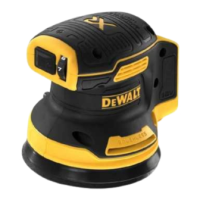29
ENGLISH
b ) Never service damaged battery packs. Service
of battery packs should only be performed by the
manufacturer or authorized serviceproviders.
Additional Safety Instructions for Sanders
• Always secure the workpiece by a clamping device or in
a bench vise in such a manner that it cannot move while
beingmachined.
• Always wear eye protection and a respirator
whensanding.
• Sanding of lead-based paint is not recommended. See
Precautions to Take When Sanding Paint for additional
information before sandingpaint.
• Do not operate the unit without the dust collection bag
or dust collectionsystem.
• Do not overload the machine by pressing with excessive
force! The best sanding results are achieved with moderate
application pressure. The sanding capacity and quality are
mainly dependent on the selection of the correctabrasive.
• Clean your tool outperiodically.
• Empty dust bag frequently, especially when sanding
resin coated surfaces such as polyurethane, varnish,
shellac, etc. Dispose of coated dust particles according to the
finish manufacturer’s guidelines, or place in a metal can with
a tight-fitting metal lid. Remove coated dust particles from the
premises daily. The accumulation of fine sanding dust particles
may self ignite and causefire.
• Replace a worn or damaged belt when it causes high
tool rpm. High tool rpm caused by a worn out belt may
result in separation of sanding pad from the sander, possibly
causing personal injury. For instructions on replacing the
belt, see Replacing the Sanding Pad and the Belt
underMaintenance.
Residual Risks
In spite of the application of the relevant safety regulations
and the implementation of safety devices, certain residual risks
cannot be avoided. These are:
• Impairment ofhearing.
• Risk of personal injury due to flyingparticles.
• Risk of burns due to accessories becoming hot
duringoperation.
• Risk of personal injury due to prolongeduse.
SAVE THESE INSTRUCTIONS
Chargers
DeWALT chargers require no adjustment and are designed to be
as easy as possible tooperate.
Electrical Safety
The electric motor has been designed for one voltage only.
Always check that the battery pack voltage corresponds to the
voltage on the rating plate. Also make sure that the voltage of
your charger corresponds to that of yourmains.
Your DeWALT charger is double insulated in
accordance with EN60335; therefore no earth wire
isrequired.
If the supply cord is damaged, it must be replaced by a
specially prepared cord available through the DeWALT
serviceorganisation.
Mains Plug Replacement
(U.K. & Ireland Only)
If a new mains plug needs to be fitted:
• Safely dispose of the oldplug.
• Connect the brown lead to the live terminal in theplug.
• Connect the blue lead to the neutralterminal.
WARNING: No connection is to be made to the
earthterminal.
Follow the fitting instructions supplied with good quality plugs.
Recommended fuse: 3A.
Using an Extension Cable
An extension cord should not be used unless absolutely
necessary. Use an approved extension cable suitable for
the power input of your charger (see Technical Data). The
minimum conductor size is 1mm
2
; the maximum length
is30m.
When using a cable reel, always unwind the cablecompletely.
Important Safety Instructions for All Battery
Chargers
SAVE THESE INSTRUCTIONS: This manual contains important
safety and operating instructions for compatible battery
chargers (refer to TechnicalData).
• Before using charger, read all instructions and cautionary
markings on charger, battery pack, and product using
batterypack.
WARNING: Shock hazard. Do not allow any liquid to get
inside charger. Electric shock mayresult.
WARNING: We recommend the use of a residual current
device with a residual current rating of 30mA orless.
CAUTION: Burn hazard. To reduce the risk of injury,
charge only DeWALT rechargeable batteries. Other types of
batteries may burst causing personal injury anddamage.
CAUTION: Children should be supervised to ensure that
they do not play with theappliance.
NOTICE: Under certain conditions, with the charger
plugged into the power supply, the exposed charging
contacts inside the charger can be shorted by foreign
material. Foreign materials of a conductive nature such
as, but not limited to, steel wool, aluminum foil or any
buildup of metallic particles should be kept away from
charger cavities. Always unplug the charger from the
power supply when there is no battery pack in the cavity.
Unplug charger before attempting to clean
• DO NOT attempt to charge the battery pack with any
chargers other than the ones in this manual. The charger
and battery pack are specifically designed to worktogether.

